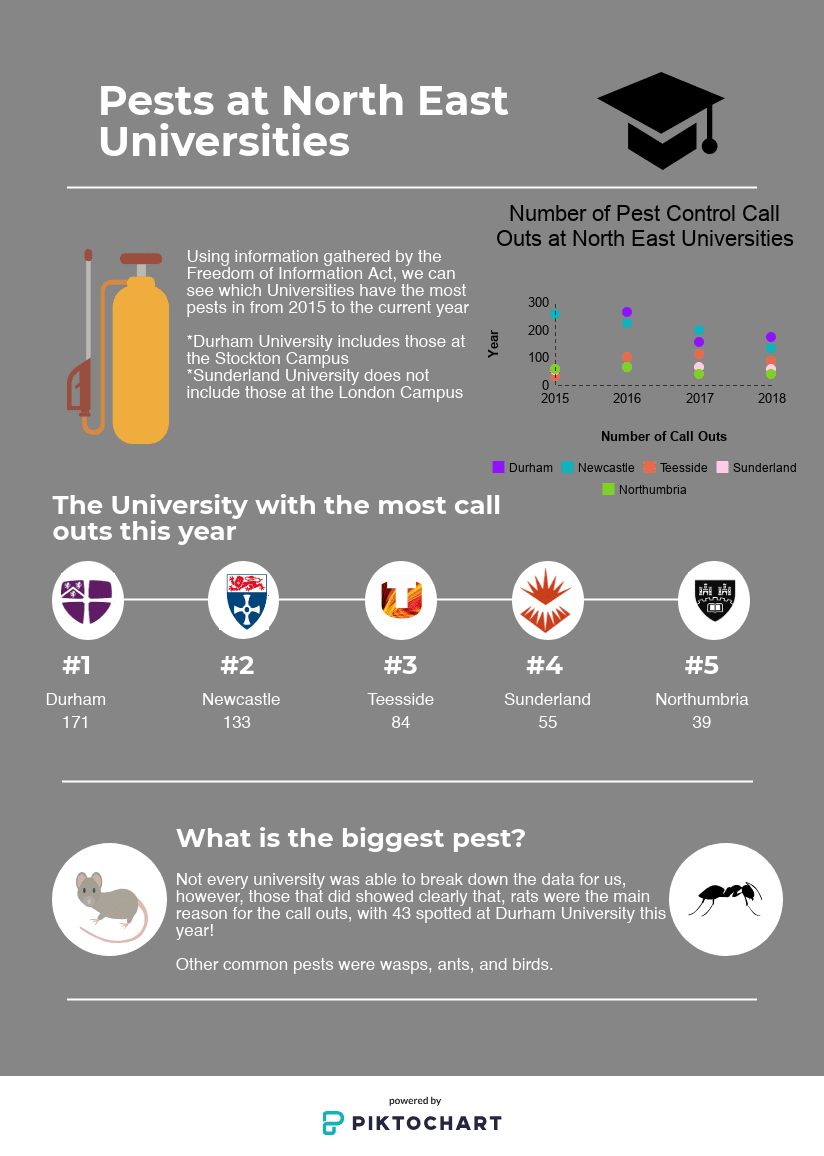There’s an old adage that you are never more than 6ft away from a rat, have you ever thought this while living in university accommodation?
SR News submitted a freedom of information request to all North East universities to find out how many pest-control callouts there have been over the period from 2015 to 2018.
The universities investigated were Durham, Newcastle, Northumbria, Sunderland and Teesside. The figures can be seen in the infographic below.

The results of the investigation show the general trend that pest-control callouts are on the increase:
Durham has had the most of all the selected universities this year. It receives a consistently high number of call-outs with 2015 being the only year lower than 100.
The only exception to the general increase is Newcastle University, which has seen a slow decline. However, between 2015 and 2016. it had the most callouts of any North East university with 254 and 221, respectively.
In 2018, Newcastle have had 133 callouts; this would be their lowest year for pest sightings but they still rank second for callouts in the North East overall.
Both Durham and Newcastle University were given a chance to respond to these findings. A spokesperson for Durham said:
“If there is a pest problem it is reported to the Estates Helpdesk and the university has an external pest provider.”
A spokesperson for Newcastle University said: “I can confirm the University employs the services of Pest Controllers who respond with appropriate actions depending upon the issue.”
Teesside’s callout figures vary: some years, such as 2017, were exceptionally high (111) and other years, like 2015, were low (30). A possible reason for the spike in 2017 is the redevelopment plan which caused parts of the university to become building sites and attract pests.
Northumbria and Sunderland’s figures are consistently low each year, with neither institution receiving over 70 callouts. Northumbria’s highest year for callouts was 2016 (63). This is extremely low compared to the other universities.
When looking at totals over the 4 years, Northumbria has the lowest numbers (196) and Newcastle has the highest (805). The results for the other universities are as follows: Sunderland (232); Teesside (323); Durham (637).
Northumbria University were asked about preventative measures in place. A spokesperson said:
“We are mostly relying on reactive callouts to our chosen service provider. We have a limited deployment of bait boxes around the University Nursery.”
Hotter summers allow the pests to breed and multiply; then, during winter, they find ways into warm buildings. 2018 was the hottest summer on record, and, with little rainfall to drown the pests, it is likely numbers will be increasing by the end of the year.
A spokesperson from the British Pest Control Association said: “All pests need three things to survive and thrive: water, shelter and food.”
“Old buildings that haven’t been well maintained create entry points for rodents. Where there are lots of people, there tends to be lots of litter. The link between litter and pests is clear. More rubbish, particularly foodstuffs, supports the emergence of pests, particularly rodent infestations.”
They also offer this advice to students:
- Eliminate any harbourage points by sealing gaps around pipes and under sheds. Rats only need a gap of 15mm to gain entry.
- Remove potential nesting sites by keeping yards and gardens clean and tidy, by cutting back overgrown areas and clearing any piles of wood or debris.
- Ensure that your drain inspection covers are in a good state of repair.
- Cover any waste where rodents can get access to it, close dustbin lids and cover compost heaps.
Some of the universities gave great detail of the specific pests recorded on the campus.
Durham University had reported incidents involving:
- Silverfish – a small wingless insect that lives off a diet of carbohydrates, they eat anything from books to carpet.
- Moths – these typically eat clothes, bedding and curtains.
- Dust-mites – these eat dust, dead skin and mould, can cause allergies and are associated with asthma and conjunctivitis.
- Rabbits – probably an escaped pet.
Newcastle University had more problems with birds such as seagulls and pigeons than with rats. There was also an incident with a bat.



